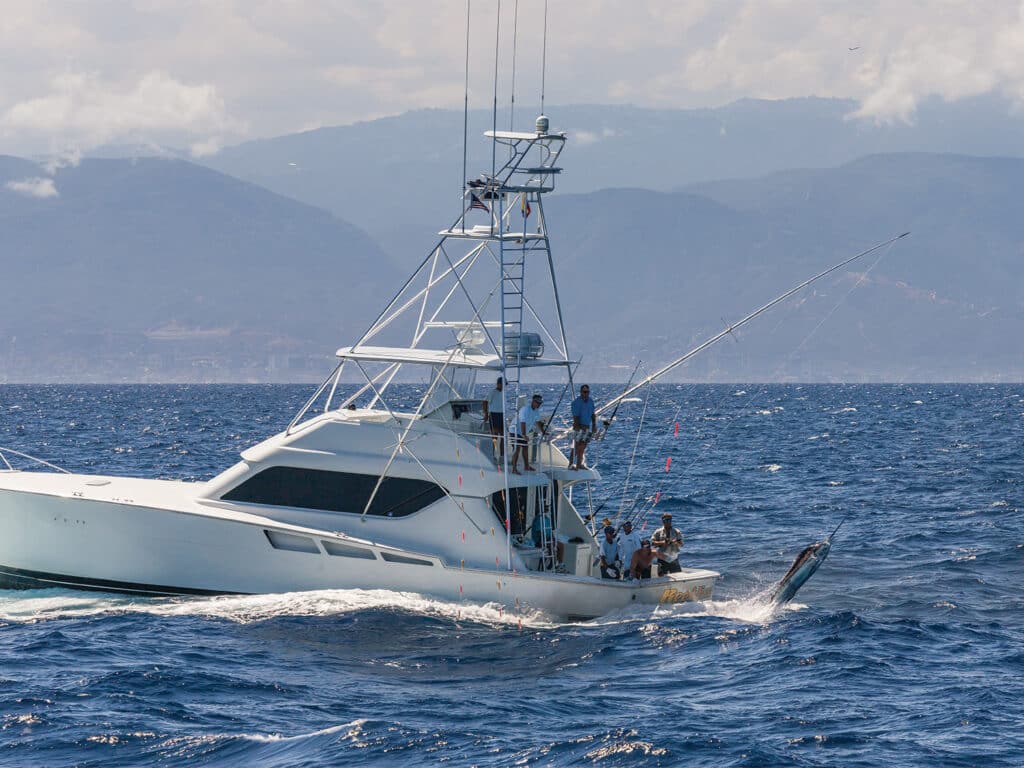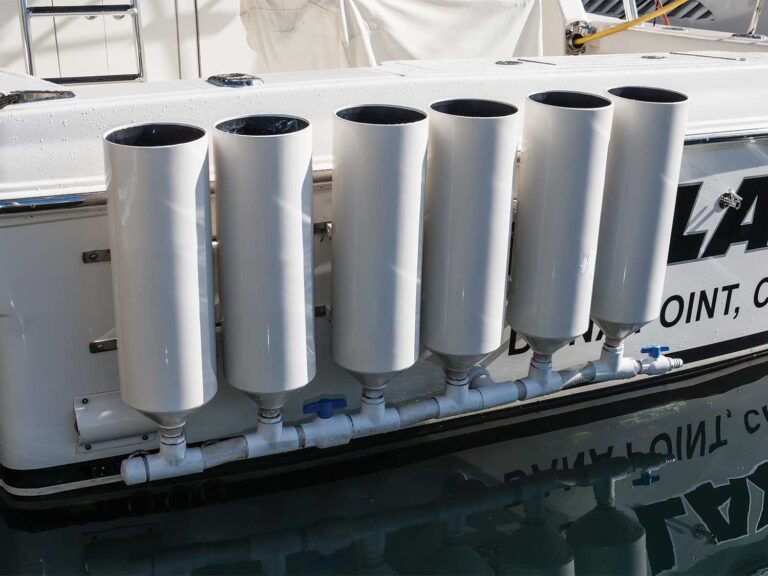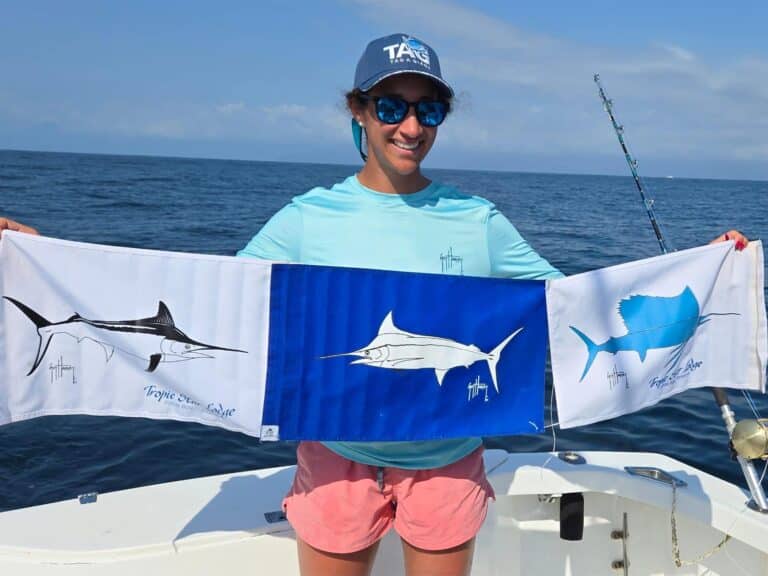
Special delivery: Sign up for the free Marlin email newsletter. Subscribe to Marlin magazine and get a year of highly collectible, keepsake editions – plus access to the digital edition and archives.
Some places are shrouded in mystique, as if dreamt up by Tolkien himself. Much as the characters of Middle-earth set out on adventures, sport-fishing boats once marched their own course south to Venezuela’s Caribbean coastline. Atop some of the world’s most hallowed billfish grounds, crews experienced fishing days spun from fantasy, with blue marlin, white marlin and sailfish charging into the spread, often all at once.
Those who had the opportunity to fish in Venezuela refer to the place with reverence and nostalgia, later met by a deep melancholy. They speak of it in the way you’d expect a leathered cowboy to share stories from long-range cattle drives under a Western sky. Tales from Venezuela are often hard to believe, but there’s ample proof of days with 30 white marlin bites, cockpits stacked to the covering boards with tunas, and countless jaw-dropping slams.
A New Destination
Venezuela wasn’t initially a typical destination for travel programs. It wasn’t until 1983, when one curious captain ventured farther south after a St. Thomas trip, that word would eventually get out about the stellar fishing in Venezuela. “Ronnie Hamlin was the first American to bring a boat down there,” says Capt. Bubba Carter, who would also eventually have his own wildly successful career in Venezuela. “He was really the one who started all the hubbub.”
Once word spread, folks considered Venezuela a reasonable stop after fishing the fall circuit in St. Thomas. A boat would have to travel just another 600 miles or so to get there, and with hurricanes often ravaging the Caribbean islands, a run south was a good strategy when fleeing storms. Soon, Venezuela was added to the travel roster.
In the first few years following Hamlin’s initial visit, he, Carter and a few others docked at the yacht club in Caraballeda, a town nestled beneath the looming mountains along the country’s central coast. Located just 14 miles or so from La Guaira Bank—an underwater ridge boasting nutrient-rich upwelling, heaps of baitfish, and a great diversity of billfish and other pelagics—Caraballeda had several marinas with Mediterranean-style stern-to dockage and a few slips. Some offered nice accommodations for crews and guests to live in during their stays in the country. For those who wanted to make other arrangements, rooms at beachfront hotels such as the Macuto Sheraton—a popular party spot—were also available.

Crews and guests could also travel in and out of the country fairly easily. The international airport in Caracas was just a 45-minute drive from Caraballeda, and direct flights from US cities were readily available. So, Venezuela wasn’t just a stellar fishing destination for sport-fishing programs; it was also a convenient one. Plus, with fuel prices as low as 10 cents per gallon, and cheap, freshly caught ballyhoo readily available, fishing there was about as cost-effective as it could get. Interest grew in the region, and so did the potential for growth.
Davenport West and his late father, Jeff, first visited Venezuela in 1991 with Eddie Windes, a professional captain who would become a crucial fishing mentor for West. The team of three ran their 48-foot Garlington to Caraballeda for the season right about the time the white marlin typically move into the area. “My dad was a bit of a maverick,” says West. “He was a dreamer and a venture capitalist. While I was wrapped up in the incredible fishing, he was putting together a vision for building a business.”
West’s father eventually bought adjacent waterfront properties in Caraballeda. By the mid-90s, Marina Portofino—a compound with 17 slips and private accommodations—was open for business. The marina was perhaps one of the most well-known and frequented sport-fishing hubs in the area, and the fishing was absolutely on fire.
A Fishing Frenzy
A long list of boats made their way to Venezuela to fish the world’s hottest bite, reading like a who’s who of the industry. A1A, Courtesan, Escapade, Revenge, Caliente, Waterman, Bree, Sharky’s Revenge, Vintage, Sassy Lady, El Zorro, Southpaw, Tijereta, Bud Man, Can’t Touch Dis, Key Venture, Sentra, Big Y, Primetime, Temptress, Alina, Whopper Stopper, Southern Comfort, Marauder, and many other talented teams added Venezuela to their schedules at some point. Some visited for a season or two, while others called the country home for years. Every boat that fished there left with a trove of epic stories. It was just that kind of place, the type that brought myth to life.
When Carter fished his first day in Venezuela, he asked Hamlin where to go to find the white marlin. “Ronnie told me to just run 270 [degrees] until the flying fish get up,” says Carter. “Then go out some more and troll the 270 until you get a bite. After that, keep going some more until you have several on. Then you’re there.”

Capt. Jimmy Grant, who had one of the longest stints in Venezuela, tallied 38 grand slams in 52 fishing days on Temptress with Capt. Chip Shafer. Yes, you read that correctly. “The potential to catch a grand slam was so high that we took it for granted,” West adds. “On any given day, you could catch five blues, seven whites and then run into shallower water to raise a triple of sails. We were so spoiled!”
After speaking with captains who visited Venezuela at different times throughout the heyday, I’ve realized that this caliber of fishing was commonplace.
On days when boats had multiple blues hooked up at once on light tackle, captains and crews had to improvise a bit. “There were times when we’d hook a double,” says Capt. Mike Merritt, “and we’d have to strap a polyball to one of the rods and throw it overboard so we could address the fish one at a time. One time I couldn’t find the polyball, so I called out over the radio for the boys to be on the lookout. Sure enough, someone found it for us. When we got to it, the fish was still on, and we got the release!”
While working as a mate on El Zorro, Capt. Robbie Moore got his introduction to just how incredible the fishery was in Venezuela before he even left the dock. “I heard this noise while I was rigging baits,” Moore recalls. “I could tell something was getting eaten, so I went to take a look. A 15-pound dolphin was chasing and eating flying fish up against the hull of the boat. That was my second or third day there. It was one of those moments when you realize you’re not in Kansas anymore.”
Capt. Dave Noling, who would go on to fish a total of 14 seasons in Venezuela, captained the West family’s boat, Courtesan, and, along with his wife, Tami, helped with various operations at Marina Portofino. Carter posits that Noling has probably caught more blue marlin than anyone else in the world, no doubt due in large part to his time in Venezuela.
“I did have one killer day that stands out from the rest,” Noling says. “I didn’t have a trip booked, so I brought Tami and my crew out for the day. We went 12 for 12, with 10 blues, one white and one sail.”
“On my best day there, we went nine for 15 on blue marlin,” Merritt recalls. “I think Dave [Noling] saw maybe 21 or 22 that day. We never knew what to expect, which is what made that place so amazing. Anything felt possible.”

Even fantasy slams weren’t out of the realm of possibilities. Escapade was the first to catch one, and another talented team would follow about a decade later. “When I was on Rob Ruwitch’s Sharky’s Revenge in 2004, Rob came down for several weeks in December,” Carter recalls. “We caught two grand slams two days in a row, so we partied hard the night before our third day. Fortunately, Venezuela was an easy place to get a late start. We caught a white, a spearfish, which was a surprise for down there, and a blue marlin right away. We then moved to the bank and caught a sail. Suddenly a fantasy slam was feasible. We just needed a swordfish. We borrowed weights, bait and squid from another boat and put two buoys out. Before the second buoy got down, we had one on. By 2 p.m., we had a fantasy slam—each of the billfish species in the Atlantic. It just took five bites to catch five different species.”
As Carter got ready to move offshore to go after the white marlin bite, Ruwitch told him to instead head to port. The team would first celebrate, and then Ruwitch was off to the airport to chase after a royal slam in record time. He flew to Hawaii, Cabo and then Australia. Within 33 days, Ruwitch had achieved what would at the time be the fastest royal slam—catching all the world’s billfish species—on record. And it all started with five bites in a few hours in Venezuela.
“Being able to go to a place to catch giant yellowfins, whites, blues and sails in the same waters was just incredible,” says Mike Kalandros, captain of A1A. “Fish were coming through there in large numbers, and up until FADs, nobody put up numbers like you could in Venezuela. Grand slams and super slams and fantasy slams—it was heaven.”

Creating Camaraderie
The Gigi fleet and other Venezuelan teams, such as the Ferrera brothers, Tropic King with Capt. Wilfredo Requeña, Marypuchy with Capt. Oscar Benitez and Joropo with Capt. Wilmer Alvarez, were largely considered some of the best in the country, and the American crews had great respect for them. “The local fishermen in Venezuela were some of the best I’ve ever met,” Grant says.
Many Venezuelans sought work on American boats, regardless of experience. Some worked as mates, while others earned cash running errands, washing boats or doing laundry. Soon, American boats employed family members of all ages, including one little kid who was so enthralled with sport fishing that he stowed away for a chance to see a billfish. He’s still in the industry today, working as a mate in the US, and you might know him as Luis Larez, or just “Speedy.”
“I started washing American boats when I was 10 years old,” Larez recalls. “My dad was a fisherman, but I hadn’t been able to fish yet because I was still too little. One day I asked a captain if I could go fishing, and he, like many others, told me I couldn’t because I was too little. Early the next morning, I climbed onto the boat and hid in the fish box. When I eventually popped out after the boat pulled back at the bank, everybody started laughing. They couldn’t believe it. I asked the captain if he was going to take me back or let me fish. I caught my first sailfish that day, and from then on, I’ve had the fever.”
By all accounts, everyone on the docks treated each other like family. “We had tents, grills, tables and chairs behind our boats to make dinner together,” Kalandros says. “That kind of camaraderie doesn’t exist anymore. We shared everything, from meals to fishing information. You know, I always want to catch one more fish than my buddy, but I still want my buddy to catch fish too. The culture has changed a lot since then.”
Captains and crews also went into town to grab dinner at local restaurants. The nearby Chinese restaurant, Hong Kong Chef, was one of the most popular spots. Not only was it a good place to grab a meal, but it was a go-to stop for all kinds of activities, ranging from exchanging money to getting roaring drunk. Polar beer, sambuca, and Aniversario and Cacique rum were in no short supply.
And while the nightly escapades and subsequent hangovers are the stuff of legends, Tami Noling was responsible for making everything at Portofino lively in the daylight hours. “Tami would organize Easter egg hunts and other family events,” says Noling. “She put on a big Thanksgiving every year that all the crews and locals would attend. I bet they still celebrate Thanksgiving down there now.”

An Era’s End
While the sport-fishing fleet enjoyed Venezuela’s excellent fishing and hospitality, the country dealt with political turmoil and extreme poverty. Some captains and mates shared stories of dead bodies along the side of the road, while others said they never felt unsafe outside of the marina. Today, according to various sources, Venezuela is in the middle of the most severe economic collapse for a non-conflict nation in almost half a century. It’s estimated that roughly 25 percent of the Venezuelan population has left the country.
Some boats left Venezuela as early as 1999 after horrific mudslides ravaged Caraballeda. It was one of the worst natural disasters of the 20th century, and it’s estimated that 30,000 people lost their lives. “We took children, friends, dogs, cats, monkeys and birds on our boats and went to Bonaire and Aruba to get them out,” says Carter. “I was one of the few Americans there through the whole thing. Most guys didn’t see all the bodies in the water. I’ll never shake that smell or the sound of helicopters flying overhead for days. It was terrible and tragic, and yet we got through it, and so did the Venezuelan people. Their resilience truly amazes me.”
Within a year and a half of the disaster, Carter was able to return to Venezuela. Some boats returned with him, while others decided to move on. However, by the late 2000s, the caustic political climate forced almost all American vessels to leave the country for good. Fuel was scarce; it had become more difficult to travel. People also feared their multimillion-dollar assets were at risk of being seized. Thus, one of the greatest eras in sport-fishing history faded into memory. “I have such mixed emotions about it,” Carter says. “I met my wife, Viviana, right there at the marina. I think we know that chapter is over, and there’s a real sadness to that. We all know it was such a special experience. Nobody can take that away from us.”
When I asked folks whether they would go back, I received mixed responses. Some said they couldn’t get the boat insured for a trip there, so it wouldn’t be an option. Others said they’d go back if fuel was readily available and the US Embassy reopened. Everyone said they would love to return, but doubts of that being a possibility within their lifetimes were palpable in nearly every conversation.

West, however, remains hopeful that American boats will one day return to the marina his father built. “People joke about how life comes around full circle,” he says. “Hopefully that will be true for me. I was there at the beginning of all of this, and there is so much potential for more. I’d really like to be there to finish the big plans my father dreamt up for Marina Portofino.”
Noling and Grant are probably the two people who are the most eager to return to Venezuela. The Nolings miss the place they called home all those years, and Grant has a son there that he doesn’t get to see often. “I’ve been to a lot of places, and I don’t get the fuzzy feeling that I got from Venezuela,” Grant says. “I thought I’d live there the rest of my life.”
Meanwhile, Larez continues to travel to and from the country to visit his wife and two sons when he gets time off. He and another Venezuelan, Alberto Sanchez, work for Noling as mates aboard Double Shot. Larez recently bought a boat and plans to run his own charter operation at home in Venezuela. “Fishing is still unbelievable,” Larez says. “Right now, guys are getting eight to 10 bites a day on blue and white marlin.” And the bite goes on. Viva Venezuela.







